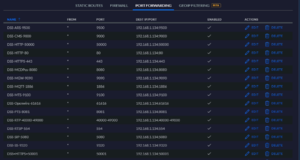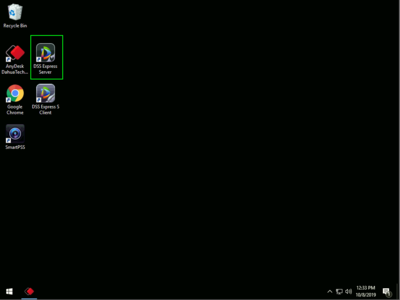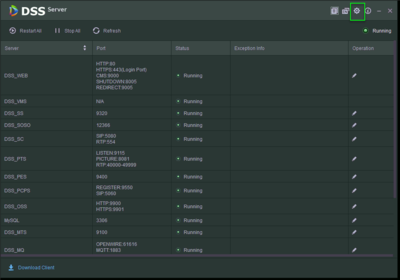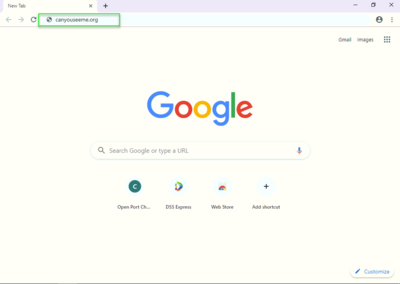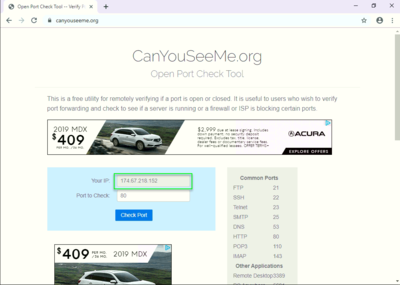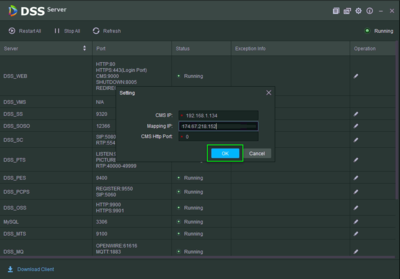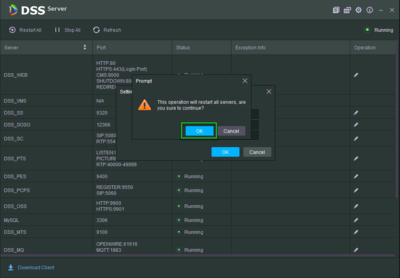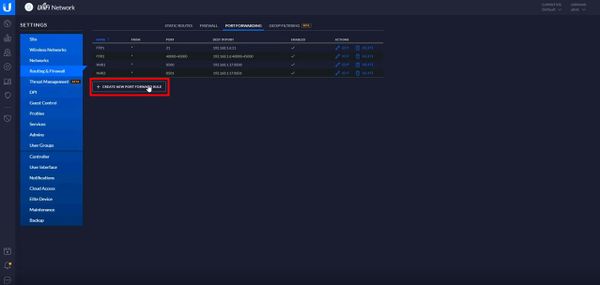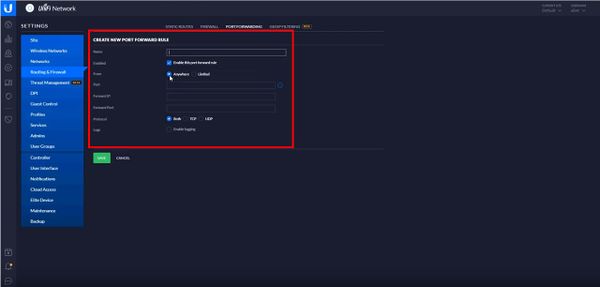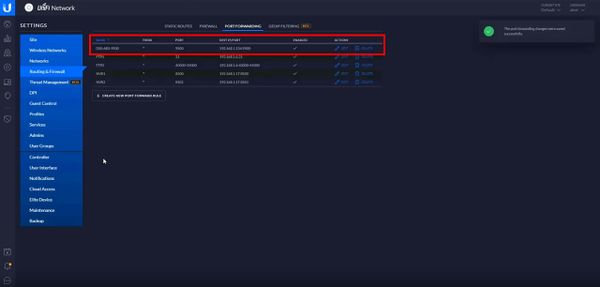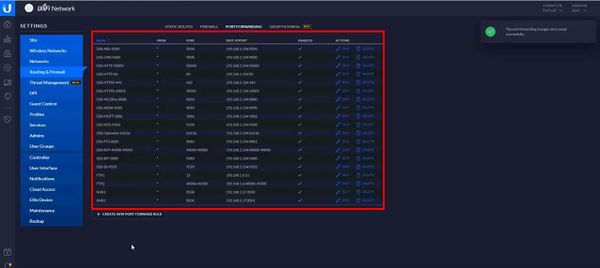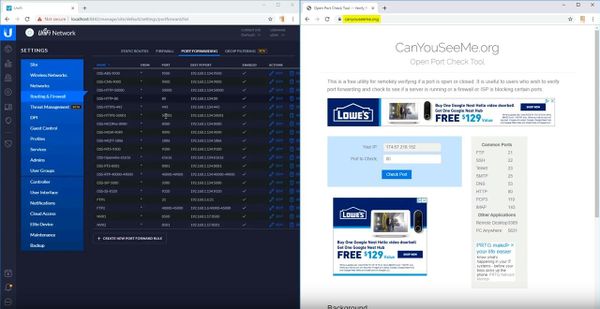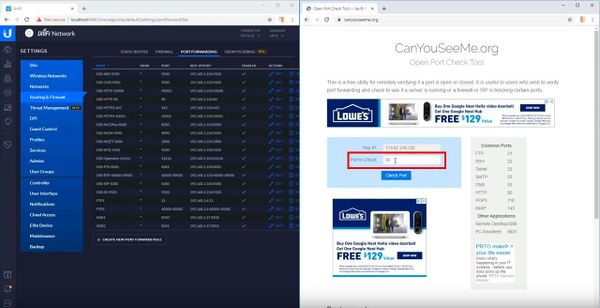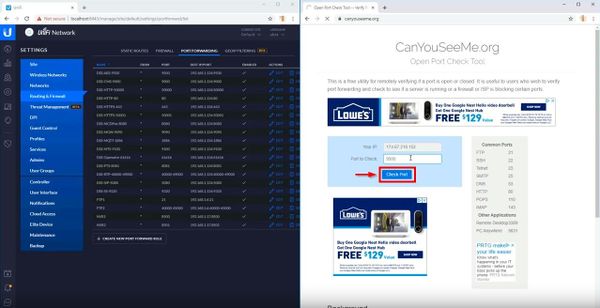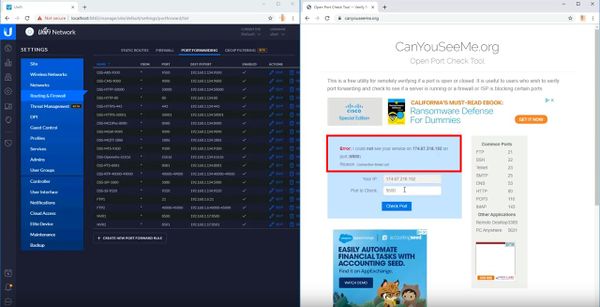Difference between revisions of "DSS Windows/Express/Remote Access Port Forwarding"
(Created page with "=DSS Express S Remote Access Setup via Port Forwarding= ==Description== ===Port List=== ==Prerequisites== *DSS Express S *IP Address of DSS Express S *User Name and Password...") |
(→Port List for DSS Express Server) |
||
| (50 intermediate revisions by 2 users not shown) | |||
| Line 1: | Line 1: | ||
| − | =DSS Express | + | =DSS Express Remote Access Setup via Port Forwarding= |
==Description== | ==Description== | ||
| − | + | These instructions will show you how to setup your DSS Express server and network so you can remotely access the DSS Express server from the DSS Client or from the DSS Mobile App. | |
==Prerequisites== | ==Prerequisites== | ||
| − | *DSS Express | + | *DSS Express |
| − | *IP Address of DSS Express | + | *IP Address of DSS Express |
*User Name and Password to router or modem | *User Name and Password to router or modem | ||
| + | |||
| + | [[File:DSS_Express_S_Port_Forwarding1.png|thumb|Example of Port Forwarding Rules in Router]] | ||
| + | ===Port List for DSS Express Server=== | ||
| + | {| class="wikitable" | ||
| + | |- | ||
| + | ! Function Module | ||
| + | ! Listening Port | ||
| + | ! Application Protocol | ||
| + | ! Required Mapping | ||
| + | |- | ||
| + | !rowspan="4"| Client login | ||
| + | |80 (NGINX: HTTP) | ||
| + | |HTTP | ||
| + | |No | ||
| + | |- | ||
| + | |443 (NGINX: HTTPS) | ||
| + | |HTTPS | ||
| + | |Yes | ||
| + | |- | ||
| + | |1883(MQ service connected by mobile app) | ||
| + | |MQ-mqtt (encrypted) | ||
| + | |Yes | ||
| + | |- | ||
| + | |61616 (MQ service connected by client) | ||
| + | |MQ-openwire (encrypted) | ||
| + | |Yes | ||
| + | |- | ||
| + | |rowspan="2" style="text-align: center;"| '''Live View''' | ||
| + | |9100 (MTS service: RTSP) | ||
| + | |RTSP | ||
| + | |Yes | ||
| + | |- | ||
| + | |9102 (MTS service: RTSPS) | ||
| + | |RTSP over TLS | ||
| + | |No | ||
| + | |- | ||
| + | !rowspan="2"|Playback | ||
| + | |9320 (SS service: RTSP) | ||
| + | |RTSP | ||
| + | |Yes | ||
| + | |- | ||
| + | |9322 (SS service: RTSPS) | ||
| + | |RTSP over TLS | ||
| + | |No | ||
| + | |- | ||
| + | |rowspan="2" style="text-align: center;"|'''DeepXplore''' | ||
| + | |9910 (subOSS service) | ||
| + | |HTTP | ||
| + | |No | ||
| + | |- | ||
| + | |9911 (subOSS service) | ||
| + | |HTTPS | ||
| + | |Yes | ||
| + | |- | ||
| + | !rowspan="3"|ANPR | ||
| + | |8081 (PTS HTTP image server) | ||
| + | |HTTP | ||
| + | |No | ||
| + | |- | ||
| + | |8082 (PTS HTTPS image server) | ||
| + | |HTTPS | ||
| + | |Yes | ||
| + | |- | ||
| + | |40000-50000 (PTS image stream) | ||
| + | |RTP | ||
| + | |Yes | ||
| + | |- | ||
| + | |rowspan="2" style="text-align: center;"|'''Video Intercom''' | ||
| + | |5080 (SC service) | ||
| + | |SIP registration port (UDP) | ||
| + | |Yes | ||
| + | |- | ||
| + | |20000-30000 (SC service audio stream) | ||
| + | |Intercom audio stream forwarding port | ||
| + | (UDP) | ||
| + | |Yes | ||
| + | |- | ||
| + | !rowspan="2"|'''Intelligent Alarm/Face/Metadata''' | ||
| + | |9900 (OSS service: HTTP) | ||
| + | |HTTP | ||
| + | |No | ||
| + | |- | ||
| + | |9901 (OSS service: HTTPS) | ||
| + | |HTTPS | ||
| + | |Yes | ||
| + | |- | ||
| + | |rowspan="2" style="text-align: center;"|'''Auto Registration''' | ||
| + | |9005 (admin service) | ||
| + | |Auto register redirection | ||
| + | |Yes | ||
| + | |- | ||
| + | |9500 (ARS service) | ||
| + | |Dahua second generation protocol | ||
| + | |Yes | ||
| + | |- | ||
| + | ! style="text-align: center;"| Access Control | ||
| + | | 9400 | ||
| + | | PES | ||
| + | | Yes | ||
| + | |} | ||
| + | |||
| + | '''If you want to use the SIP function of DSS Mobile for VDP, you need to map 20000-30000 ports''' | ||
| + | |||
| + | ===Port List for Remote Dahua IP Camera or Recorder=== | ||
{| class="wikitable" | {| class="wikitable" | ||
!|Port | !|Port | ||
!|Server | !|Server | ||
!|Function | !|Function | ||
| + | |- | ||
| + | |80 | ||
| + | |HTTP | ||
| + | |Responsible for HTTP protocol client login | ||
| + | |- | ||
| + | |37777 | ||
| + | |HTTPS | ||
| + | |Responsible for HTTPS protocol client and web login | ||
| + | |- | ||
| + | |554 | ||
| + | |RTSP | ||
| + | | | ||
| + | |} | ||
| + | |||
| + | ==Instructions== | ||
| + | ===Identify & Set WAN and LAN IP Address of DSS Express Server=== | ||
| + | ====Video Instructions==== | ||
| + | <embedvideo service="youtube">https://youtu.be/ATlxsSpms1E</embedvideo> | ||
| + | ====Step by Step Instructions==== | ||
| + | 1. Open the DSS Express Server configuration | ||
| + | |||
| + | [[File:DSS_Express_S_Port_Forwarding2.png|400px]] | ||
| + | |||
| + | 2. Click the gear icon in the top right to change the IP information of the server | ||
| + | |||
| + | [[File:DSS_Express_S_Port_Forwarding3.png|400px]] | ||
| + | |||
| + | 3. The Setting window will display the current IP information for the server | ||
| + | |||
| + | [[File:DSS_Express_S_Port_Forwarding4.png|400px]] | ||
| + | |||
| + | 4. To find out the public IP for the network, start by opening a web browser and go to | ||
| + | |||
| + | www.canyouseeme.org | ||
| + | |||
| + | [[File:DSS_Express_S_Port_Forwarding5.png|400px]] | ||
| + | |||
| + | 5. The IP listed as "Your IP" will be the public IP as determined by the website | ||
| + | |||
| + | [[File:DSS_Express_S_Port_Forwarding6.png|400px]] | ||
| + | |||
| + | 6. Enter this address into the "Mapping IP" field in the DSS Server Configuration | ||
| + | |||
| + | [[File:DSS_Express_S_Port_Forwarding7.png|400px]] | ||
| + | |||
| + | '''Be sure to note the CMS IP address, we will be using that IP address to forward the ports in the next step.''' | ||
| + | |||
| + | [[File:DSS_Express_S_Port_Forwarding8.png|400px]] | ||
| + | |||
| + | 7. Click OK once the information has been entered | ||
| + | |||
| + | [[File:DSS_Express_S_Port_Forwarding9.png|400px]] | ||
| + | |||
| + | 8. You will receive a prompt to confirm a restart of the server to make the network changes. Click OK to proceed | ||
| + | |||
| + | [[File:DSS_Express_S_Port_Forwarding10.png|400px]] | ||
| + | |||
| + | ===Forward Ports in Router or Modem=== | ||
| + | |||
| + | ''Please note the screenshots in this guide may not match identically to the modem/router being used with the DSS, but will be helpful as a reference in configuring the correct Port Forwarding rules. | ||
| + | |||
| + | If more direct instructions are required, please refer to www.PortForward.com to find a step by step guide for your specific make/model of modem/router'' | ||
| + | |||
| + | ====Video Instructions==== | ||
| + | <embedvideo service="youtube">https://youtu.be/0Nvxe2kjkKs</embedvideo> | ||
| + | ====Step by Step Instructions==== | ||
| + | 1. Log into the router and navigate to the Firewall / Routing section | ||
| + | |||
| + | [[File:DSS_Express_Port_Forwarding_1.jpg|600px]] | ||
| + | |||
| + | 2. Create a new port forwarding rule | ||
| + | |||
| + | [[File:DSS_Express_Port_Forwarding_2.jpg|600px]] | ||
| + | |||
| + | 3. Enter all information for the port forwarding rule: | ||
| + | |||
| + | *Name - nickname for Port Forward Rule | ||
| + | *Port - desired port to be opened | ||
| + | *Forward IP - CMS IP , found in the previous steps in the DSS Server configuration | ||
| + | *Protocol - Both (TCP, UDP) | ||
| + | |||
| + | [[File:DSS_Express_Port_Forwarding_3.jpg|600px]] | ||
| + | |||
| + | Click Save once the parameters have been entered | ||
| + | |||
| + | 4. The created port forwarding rule will appear in the list. | ||
| + | |||
| + | Repeat the process to create new rules, for every port that is required for DSS functions (refer to above chart) | ||
| + | |||
| + | [[File:DSS_Express_Port_Forwarding_4.jpg|600px]] | ||
| + | |||
| + | 5. A full list of forwarded ports for the DSS Express | ||
| + | |||
| + | [[File:DSS_Express_Port_Forwarding_5.jpg|600px]] | ||
| + | |||
| + | ===Verify Ports are Open=== | ||
| + | ====Video Instructions==== | ||
| + | <embedvideo service="youtube">https://youtu.be/y-lca2BmWXs</embedvideo> | ||
| + | ====CanYouSeeMe.org Test Table==== | ||
| + | {| class="wikitable" | ||
| + | !|Port | ||
| + | !|Server | ||
| + | !|Test Result | ||
| + | |- | ||
| + | |80 | ||
| + | |HTTP | ||
| + | | style="background-color:#90EE90;"|Success! Your ISP is not blocking port 80 | ||
| + | |- | ||
| + | |443 | ||
| + | |HTTPS | ||
| + | | style="background-color:#90EE90;"|Success! Your ISP is not blocking port 80 | ||
|- | |- | ||
|9000 | |9000 | ||
|CMS | |CMS | ||
| − | | | + | | style="background-color:#90EE90;"|Success! Your ISP is not blocking port 80 |
|- | |- | ||
| − | | | + | |9320 |
| − | | | + | |SS |
| − | | | + | | style="background-color:#90EE90;"|Success! Your ISP is not blocking port 80 |
|- | |- | ||
| − | | | + | |5080 |
| − | | | + | |SIP |
| − | | | + | | style="background-color:#ffcccb;"|Error! |
|- | |- | ||
| − | | | + | |8081 |
| − | | | + | |PTS |
| − | | | + | | style="background-color:#90EE90;"|Success! Your ISP is not blocking port 80 |
|- | |- | ||
| − | | | + | |40000-49000 |
| − | | | + | |RTP |
| − | | | + | | style="background-color:#ffcccb;"|Error! |
|- | |- | ||
| − | | | + | |50000 |
| − | | | + | |HTTP |
| − | | | + | | style="background-color:#ffcccb;"|Error! |
|- | |- | ||
| − | | | + | |50001 |
| − | | | + | |HTTPS |
| − | | | + | | style="background-color:#ffcccb;"|Error! |
|- | |- | ||
| − | | | + | |9100 |
| − | | | + | |MTS |
| − | | | + | | style="background-color:#90EE90;"|Success! Your ISP is not blocking port 80 |
|- | |- | ||
| − | | | + | |61616 |
| − | | | + | |Openwire |
| − | | | + | | style="background-color:#90EE90;"|Success! Your ISP is not blocking port 80 |
|- | |- | ||
| − | | | + | |1886 |
| − | | | + | |MQTT |
| − | | | + | | style="background-color:#ffcccb;"|Error! |
|- | |- | ||
| − | | | + | |9090 |
| − | | | + | |DSS_MGW |
| − | | | + | | style="background-color:#90EE90;"|Success! Your ISP is not blocking port 80 |
|- | |- | ||
| − | | | + | |8080 |
| − | | | + | |DSS_MCDPos |
| − | | | + | | style="background-color:#ffcccb;"|Error! |
|- | |- | ||
| − | | | + | |9500 |
| − | | | + | |ARS |
| − | | | + | | style="background-color:#ffcccb;"|Error! |
|- | |- | ||
|} | |} | ||
| − | == | + | |
| − | + | ====Step by Step Instructions==== | |
| − | + | 1. Open a web browser and go to | |
| − | + | ||
| + | www.canyouseeme.org | ||
| + | |||
| + | [[File:DSS_Express_Port_Forwarding_-_Verify_1_.jpg|600px]] | ||
| + | |||
| + | 2. Enter a Port number in "Port to Check" field to test | ||
| + | |||
| + | [[File:DSS_Express_Port_Forwarding_-_Verify_2_.jpg|600px]] | ||
| + | |||
| + | 3. Click Check Port | ||
| + | |||
| + | [[File:DSS_Express_Port_Forwarding_-_Verify_3_.jpg|600px]] | ||
| + | |||
| + | 4. The result will be displayed | ||
| + | |||
| + | Example of blocked port: | ||
| + | |||
| + | [[File:DSS_Express_Port_Forwarding_-_Verify_4_.jpg|600px]] | ||
| + | |||
| + | Example of open port: | ||
| + | |||
| + | [[File:DSS_Express_Port_Forwarding_-_Verify_5_.jpg|600px]] | ||
Latest revision as of 16:26, 13 July 2022
Contents
DSS Express Remote Access Setup via Port Forwarding
Description
These instructions will show you how to setup your DSS Express server and network so you can remotely access the DSS Express server from the DSS Client or from the DSS Mobile App.
Prerequisites
- DSS Express
- IP Address of DSS Express
- User Name and Password to router or modem
Port List for DSS Express Server
| Function Module | Listening Port | Application Protocol | Required Mapping |
|---|---|---|---|
| Client login | 80 (NGINX: HTTP) | HTTP | No |
| 443 (NGINX: HTTPS) | HTTPS | Yes | |
| 1883(MQ service connected by mobile app) | MQ-mqtt (encrypted) | Yes | |
| 61616 (MQ service connected by client) | MQ-openwire (encrypted) | Yes | |
| Live View | 9100 (MTS service: RTSP) | RTSP | Yes |
| 9102 (MTS service: RTSPS) | RTSP over TLS | No | |
| Playback | 9320 (SS service: RTSP) | RTSP | Yes |
| 9322 (SS service: RTSPS) | RTSP over TLS | No | |
| DeepXplore | 9910 (subOSS service) | HTTP | No |
| 9911 (subOSS service) | HTTPS | Yes | |
| ANPR | 8081 (PTS HTTP image server) | HTTP | No |
| 8082 (PTS HTTPS image server) | HTTPS | Yes | |
| 40000-50000 (PTS image stream) | RTP | Yes | |
| Video Intercom | 5080 (SC service) | SIP registration port (UDP) | Yes |
| 20000-30000 (SC service audio stream) | Intercom audio stream forwarding port
(UDP) |
Yes | |
| Intelligent Alarm/Face/Metadata | 9900 (OSS service: HTTP) | HTTP | No |
| 9901 (OSS service: HTTPS) | HTTPS | Yes | |
| Auto Registration | 9005 (admin service) | Auto register redirection | Yes |
| 9500 (ARS service) | Dahua second generation protocol | Yes | |
| Access Control | 9400 | PES | Yes |
If you want to use the SIP function of DSS Mobile for VDP, you need to map 20000-30000 ports
Port List for Remote Dahua IP Camera or Recorder
| Port | Server | Function |
|---|---|---|
| 80 | HTTP | Responsible for HTTP protocol client login |
| 37777 | HTTPS | Responsible for HTTPS protocol client and web login |
| 554 | RTSP |
Instructions
Identify & Set WAN and LAN IP Address of DSS Express Server
Video Instructions
Step by Step Instructions
1. Open the DSS Express Server configuration
2. Click the gear icon in the top right to change the IP information of the server
3. The Setting window will display the current IP information for the server
4. To find out the public IP for the network, start by opening a web browser and go to
www.canyouseeme.org
5. The IP listed as "Your IP" will be the public IP as determined by the website
6. Enter this address into the "Mapping IP" field in the DSS Server Configuration
Be sure to note the CMS IP address, we will be using that IP address to forward the ports in the next step.
7. Click OK once the information has been entered
8. You will receive a prompt to confirm a restart of the server to make the network changes. Click OK to proceed
Forward Ports in Router or Modem
Please note the screenshots in this guide may not match identically to the modem/router being used with the DSS, but will be helpful as a reference in configuring the correct Port Forwarding rules.
If more direct instructions are required, please refer to www.PortForward.com to find a step by step guide for your specific make/model of modem/router
Video Instructions
Step by Step Instructions
1. Log into the router and navigate to the Firewall / Routing section
2. Create a new port forwarding rule
3. Enter all information for the port forwarding rule:
- Name - nickname for Port Forward Rule
- Port - desired port to be opened
- Forward IP - CMS IP , found in the previous steps in the DSS Server configuration
- Protocol - Both (TCP, UDP)
Click Save once the parameters have been entered
4. The created port forwarding rule will appear in the list.
Repeat the process to create new rules, for every port that is required for DSS functions (refer to above chart)
5. A full list of forwarded ports for the DSS Express
Verify Ports are Open
Video Instructions
CanYouSeeMe.org Test Table
| Port | Server | Test Result |
|---|---|---|
| 80 | HTTP | Success! Your ISP is not blocking port 80 |
| 443 | HTTPS | Success! Your ISP is not blocking port 80 |
| 9000 | CMS | Success! Your ISP is not blocking port 80 |
| 9320 | SS | Success! Your ISP is not blocking port 80 |
| 5080 | SIP | Error! |
| 8081 | PTS | Success! Your ISP is not blocking port 80 |
| 40000-49000 | RTP | Error! |
| 50000 | HTTP | Error! |
| 50001 | HTTPS | Error! |
| 9100 | MTS | Success! Your ISP is not blocking port 80 |
| 61616 | Openwire | Success! Your ISP is not blocking port 80 |
| 1886 | MQTT | Error! |
| 9090 | DSS_MGW | Success! Your ISP is not blocking port 80 |
| 8080 | DSS_MCDPos | Error! |
| 9500 | ARS | Error! |
Step by Step Instructions
1. Open a web browser and go to
www.canyouseeme.org
2. Enter a Port number in "Port to Check" field to test
3. Click Check Port
4. The result will be displayed
Example of blocked port:
Example of open port:
